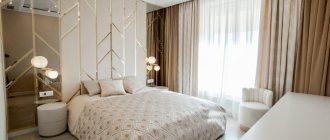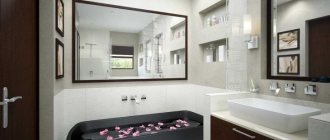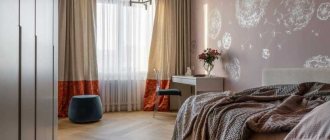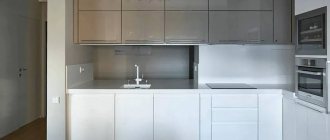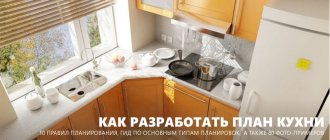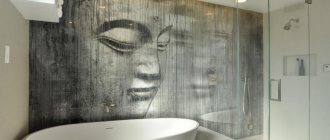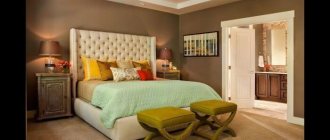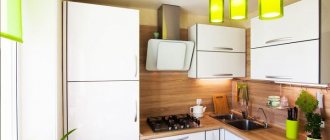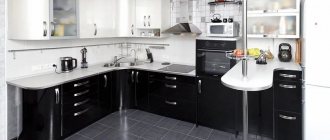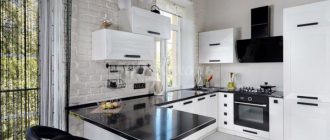When planning the decoration of an apartment or house, more attention is paid to large rooms: living room, kitchen or bedroom. Despite the small area, the design of the bathroom is no less important. The toilet should be comfortable, functional and practical. A little imagination, careful study of details and finishing materials will create a stylish environment.
How to choose an interior style for a toilet
You need to choose it in accordance with the design of the apartment in order to avoid contrast and disharmony.
Minimalism
This is one of the most popular trends in interior design. It is often used for bathrooms and bathrooms, since it combines conciseness, elegance, and the absence of sharp contrasts. There are natural materials (wood, stone, glass) or their imitation in combination with pastel colors and muted shades.
Minimalism has no unnecessary details or decorative elements, which makes cleaning the room much easier.
Scandinavian
There are laconic forms and natural materials here. This style is characterized by:
- Functionality – built-in furniture, closed storage areas.
- Monochrome – the color scheme involves an abundance of light (mainly white or pastel) tones.
- Free space - all furniture is narrow and located around the perimeter of the walls, which allows you to free up space in the center of the room.
- Furniture and decoration made from natural materials – in Scandinavian countries, natural materials are often used in interior design.
Light shades visually expand the space, and flowers in vases and wooden figurines bring coziness.
In such a room, white plumbing fixtures are most often used, and the tiles on the floor imitate natural stone or wood.
Provence
This style is used in large bathrooms, where there is space for furniture, decorative elements and textiles. Pastel shades combined with floral patterns create a feeling of lightness and warmth. A table or cabinet made of natural wood in light colors, towels made of linen or cotton fabric, flower pots and carpets on the floor - all these are attributes of Provence.
Ecostyle
He is now at the peak of popularity. Its main feature is the use of natural materials:
- wooden panels;
- stone (marble, granite);
- plants (flowers, trees, vines).
This style uses only natural colors, mostly muted:
- beige;
- cream;
- white;
- black;
- grey.
Loft
Suitable for decorating a bathroom because it combines simplicity, practicality and aesthetics. Open communications, matte wall and floor coverings, brick inserts and wood panels, natural shades and the absence of accessories - all this unites the loft - a functional and at the same time cozy interior with white fixtures and dim lighting.
High tech
High-tech is the technology of the latest models, glossy chrome parts, an abundance of dark tones and reflective surfaces. This design has no unnecessary elements or decor. It is as concise and convenient as possible.
High-tech implies multi-level lighting, which can be achieved through built-in lamps. The closed storage system dominates here. Open shelving most often remains empty.
Art Deco
An Art Deco bathroom combines elegance, glamor and luxury. The dominant colors are contrasting black and white, but other shades may also be present:
- red;
- green;
- gold;
- silver, etc.
Various accessories such as towels, vases, and textiles are used as bright accents.
This style is dominated by square shapes, corner fixtures and furniture. The walls and floor are decorated with geometric patterns. Wallpaper and painted surfaces are allowed.
Chrome handles and holders, frosted glass are mandatory attributes of Art Deco. And light shades, mirrors and glossy surfaces add a cozy atmosphere.
Neoclassical
Neoclassicism is a sophisticated design that has come down to us from past centuries and has absorbed all the elegance of palace interiors.
The main features of this direction:
- Symmetry. The absence of irregular shapes and bright accents, inclusions of other styles, etc.
- Pastel shades. An abundance of white and cream shades, giving a feeling of light and spaciousness.
- Small decorative elements. Unlike the classics, this interior does not use heavy stucco molding, bulky monograms or rough carvings.
- Plenty of free space. This style is used in spacious rooms with high ceilings and windows. The center of the room is most often empty.
- Stucco molding. In neoclassical design, large and wide stucco decoration is used, but in most cases it is smooth (without bends, patterns or monograms).
- Bay windows. Windows are rare in bathrooms, but in some buildings from Tsarist times there are bay windows. It is better to decorate such rooms in a neoclassical style, since with its help it will be possible to create the effect of lightness, freedom and spaciousness.
- High-quality natural materials. Such an interior involves the use of porcelain stoneware, marble, furniture made of natural wood, etc.
- Moldings. These decorative elements will decorate the room and give it sophistication and elegance. With their help, you can hide various imperfections, hide protruding elements, etc.
Fashionable colors in 2022
In 2022, muted pink-gray shades and various combinations of white-brown, cream, caramel, gold and other colors are in fashion. Grayish-blue and smoky tones are often found in modern design ideas.
The calm color palette looks elegant and adds softness and charm to the interior.
Quality of plumbing equipment
There is no doubt that the quality and comfort of a bathroom are determined to a greater extent by its technical equipment. The latest trends in this area have been the reduction in size and ease of use of such equipment.
Toilet design rules
In a small space, every detail matters. Therefore, you need to think through everything in advance and organize the arrangement of objects so that the room is functional and comfortable.
Hanging installation is the best choice
A wall-hung toilet outperforms a floor-mounted one in many respects:
- Elegant look.
- There is no joint with the floor and no gap between the toilet and the floor tiles.
- Free space on the floor, which makes cleaning the room easier and frees up additional space.
- Visual expansion of space due to the fact that the installation does not touch the floor.
All these advantages allow you to create comfortable conditions in the bathroom without overloading the space with bulky plumbing fixtures.
Technical hatch equipment for pipes and meters
The use of a white metal hatch is a rough finishing option and does not fit into the modern interior. To hide pipes and other communications, it is recommended to use:
- Hatch hidden under ceramic tiles.
- Furniture doors.
- A painting or panel.
- Roller blinds.
Exposed pipes and counters can disrupt the style of the room.
The hatch hidden under the tile will have wide, dark gaps around the perimeter. To avoid contrast, you need to use dark grout for all tiles in the bathroom.
Having a small sink
In the toilet, it is important to be able to wash your hands without leaving the room and without coming into contact with door handles. To do this, it is recommended to equip a small sink in a small space. Models come in different sizes and configurations, including corner ones. You need to choose them depending on the style of the room and the amount of free space on the load-bearing wall.
Area more than 2 sq. m
On an area of more than 2 sq. m you can put various items, in particular a washing machine or a cabinet for storing household items, in order to make maximum use of the usable space.
In addition, such a bathroom will accommodate a bidet, drying machine, and boiler.
In a large room you can put a coffee table or cabinet.
Maximum two colors in finishing
The decoration of the toilet should not contain more than 2 shades (not taking into account the color of the plumbing). Especially if they contrast with the latter. An exception to this rule may be patchwork, where the colors are not dominant and do not draw attention to themselves.
It is undesirable to decorate the walls in dark colors in a small toilet. It is better to choose a light palette and pastel shades (beige, caramel, light gray, ivory). This will visually expand the space.
If you need to create a bright design, it is better to choose colors in advance and check them for compatibility.
Decorative lighting
Decorative lighting is used in the toilet and as main lighting. Dim light will be enough, since in this room there is no need to perform hygiene procedures and look in the mirror.
The trend in the design of bathrooms is lighting the floor and the middle part of the wall along the perimeter. Light sources can be hidden in recesses in the wall specially designed for this purpose. The play of light and shadow will create a mysterious and intimate atmosphere. At the same time, the interior will look restrained.
Textured tiles in wall decoration will create the effect of a voluminous and complex space.
LED lamps are placed according to your own imagination, creating interesting combinations and patterns. You can use a profile with a light-scattering screen, etc.
The presence of a holder for a brush on the wall
There are no small details in interior design, so all accessories need to be thought through and selected in advance, including a toilet brush. It is better to purchase a design with a holder where this item can be placed. Modern designs rarely use floor options.
Selected in color and style and in harmony with the plumbing, such a piece of furniture will look stylish and will not cause negative associations.
Choosing plumbing fixtures and furniture
The modern market presents a variety of toilet models. They are conventionally divided into three categories:
- suspended structure;
- wall-mounted toilet;
- floor toilet.
The choice of product is determined by the size of the bathroom, budget and personal preferences. Each option has its own advantages and disadvantages that should be considered before purchasing.
Suspended structure
The console toilet is a false wall in which the flush cistern is hidden, as well as sewer and water pipes. In this case, only the bowl and the drain button remain visible. All insides are reliably protected from condensation and water overflow.
Pros:
- easy cleaning;
- durability and practicality of the design;
- saving space in the bathroom.
Minuses:
- the design requires the installation of an additional partition;
- hanging installation is expensive;
- It is necessary to install water filters.
Floor mounted toilet
Involves the presence of a hidden cistern. In essence, this is the same installation as a wall-hung toilet, except that the device itself stands on the floor and does not have a load-bearing frame.
Reference! It can be mounted using profiles or simply embedded into the wall.
Pros:
- the absence of a tank makes the interior more comfortable and stylish;
- silent water drainage;
- comfortable cleaning.
Minuses:
- it is necessary to construct a niche where the tank is hidden;
- inconvenient access to pipes for repair or maintenance work.
Floor standing toilet
The traditional shape of the toilet, which is available in two versions: monoblock or compact. The compact may have a pre-installed and connected tank or separate parts that require assembly. The monoblock is a monolithic structure of a toilet bowl and cistern.
Pros:
- simple installation and maintenance;
- large range of models;
- Possibility of quick replacement in case of breakdown.
Minuses:
- presence of hard-to-reach places for cleaning;
- open communication pipes;
- noise during use;
- fogging of the tank.
If the bathroom area is large enough, it is advisable to install a small sink. At the same time, you can find small-sized models of washbasins designed for small spaces:
- narrow rectangular sinks with a tap located on the side;
- corner models with rounded corners;
- corner models in the form of a triangle;
- round compact sinks for installation in a corner;
- oval elongated washbasins located along the wall.
The color of plumbing fixtures can be completely different. On the modern market you can find toilets and sinks painted in various colors and shades.
Selection of finishing materials
Finishing materials must be carefully selected, taking into account the following room parameters:
- square;
- height;
- humidity;
- design, etc.
For walls
The most popular material for wall decoration is ceramic tiles, as they have the following advantages:
- It can be used to lay out not only load-bearing surfaces, but also various structures that hide communications (pipes, meters, etc.).
- It withstands the effects of various external factors (moisture, cold, heat), chemicals (detergents and disinfectants, abrasives).
- Aesthetics and a large selection of shapes, colors and textures make it a leader among coatings for bathrooms and kitchens.
Plastic panels are also used for finishing, since their cost is significantly lower than that of tiles. However, this material is less practical because it does not tolerate exposure to aggressive chemical environments (cleaning agents containing chlorine, abrasives, etc.). However, if the budget for repairs is small, this option will be optimal. In addition, this material has many colors and patterns with which you can create your own toilet design.
Wood and MDF panels are found quite often in the decoration of bathrooms. These options are more demanding to care for and require increased attention because they do not tolerate moisture and aggressive detergents. This cladding is suitable for more spacious rooms decorated in a classic or country style. If preference is given to finishing with wood only because of its texture, then it is better to choose tiles that imitate it.
Facing stones and bricks are used less frequently because they are difficult to keep clean due to their uneven, porous surface. Immediately after finishing the masonry, such material is opened with varnish.
Mosaics or pebbles are often used to decorate a toilet. This design looks stylish, especially if these materials are used to decorate individual fragments of surfaces.
Tempered glass is used as a backsplash, especially if the toilet is wallpapered or painted. The transparent surface is attached to the middle of the wall.
For floor
For finishing the floor, hardened ceramic tiles are used, which can withstand increased loads. It has the following characteristics:
- water resistance;
- durability;
- practicality;
- environmental friendliness.
The most popular is tile that imitates natural materials (wood, stone).
Sometimes linoleum is used to decorate the toilet. It is suitable for rooms with low humidity levels.
For the ceiling
The following materials are used to decorate the ceiling:
- plastic panels;
- suspended aluminum structures;
- PVC film (tension surface).
Painting or whitewashing of a pre-leveled surface is also used.
It is necessary to take into account the conditions in the bathroom. If the air in this room is damp and cold, then it is best to use waterproof materials such as plastic and PVC.
Is it worth hanging pictures?
It is not advisable to decorate the interior of the bathroom with reproductions of popular artists, works of art, etc. You can hang one or several paintings without intricate patterns or plot. The main rule is that the work matches the style of the interior.
Canvases depicting fish, animals, and various abstractions will look advantageous against a dark, monochromatic background. On the bright side there are paintings in large openwork frames.
If the main decoration contains delicate buds, then paintings in pastel shades with flowers and floral patterns will suit it. Images of various insects, butterflies, etc. are combined with country style.
In the bathroom you can hang landscapes, paintings with a marine theme, nude figures, etc. In addition, such rooms are decorated with embroidered canvases and panels (if there is good ventilation).
Additional Toilet Design Tips
The design of the toilet should include convenience and practicality. You need to pay attention to certain parameters, such as:
- convenient arrangement of furniture and plumbing;
- competent design of space;
- correct lighting, etc.
Convenient location
In small bathrooms, every interior detail should be practical. It is important to position all items correctly so that there is no discomfort during their use.
In larger rooms, you can install shelving or equip a built-in closet for household items. However, in a small toilet, even the location of the toilet plays an important role. Therefore, if you have an inconvenient layout, you need to think carefully and plan everything. You may need to move some items, create a niche behind the toilet, hiding it with decorative panels or doors.
Decorating with additional accessories
Accessories are only appropriate in rooms whose area exceeds 2 square meters. m. Otherwise, the room will look overloaded.
When designing some styles, a large number of living plants (ecostyle), textiles (Provence), wicker furniture (eclecticism) and decorative elements (country, avant-garde, etc.) are used. However, in small bathrooms, all additional items should be of practical importance.
If the room is spacious, then the decor may include figurines, vases, baskets, etc.
How to visually expand a narrow space
A small space can be expanded using various techniques:
- glossy surfaces;
- mirrors;
- photo wallpapers or 3D drawings on the walls, floor;
- light shades.
It is permissible to use them simultaneously.
To “expand” a narrow room, it is necessary to place reflective surfaces or mirror tiles on the two front walls. To “lengthen” the room, on the wall opposite the entrance, you can paste photo wallpaper with a landscape receding into the distance.
Proper lighting
The lighting in the toilet should be sufficient, but not too bright and harsh on the eyes. It is best to use not the central one, but one located around the perimeter of the room (LED strips, spotlights, etc.). This will help create the effect of mystery and at the same time lightness. It will be pleasant to stay in such a room for a long time.
Light sources can be hidden in special recesses under the ceiling, along the wall or in furniture.
Maintaining ergonomics
Ergonomics is the main criterion for the design of small bathrooms. Here you need to think about the most optimal placement of all the necessary items: boiler, washing machine, sink, bidet, etc.
You can ask a designer for help or calculate the size of furniture and plumbing fixtures yourself. You should use the maximum amount of free space around the perimeter of the walls (corners, niches, protrusions), and select suitable models of equipment.
Masking the unnecessary
Pipes, wires, meters must be hidden to create a cozy atmosphere in the room. To disguise various objects and communications, special decorative panels, frames with hinged or sliding doors, paintings, panels, etc. are used.
However, there are styles that provide for open communications: loft, brutal, etc. In them, these objects are put on display, but they are given a more attractive appearance (painted, sanded, treated with special compounds).
Fashionable toilet furniture
Nowadays, furniture that looks monolithic has become fashionable. There are no handles on it, the joints with doors and drawers are barely visible, which creates the effect of a complete surface. Furniture with patterns and other decorative elements is not popular in 2022.
Designers choose furniture whose surface imitates natural materials (granite, wood). Such items should be in harmony with the wall decoration and match the style of the room.
Lighting organization
Lighting is divided into main and additional. The main ones used are built-in lamps with frosted glass shades or small spotlights.
Additional lighting can be arranged around individual zones in the form of an LED strip (under the bathtub or in a recess under the ceiling). Mirrors must be accompanied by lighting.
Switches and sockets must be equipped with special anti-drip protection.
The main mistakes when arranging a toilet room
When decorating a bathroom, many people make serious mistakes. To avoid this, it is necessary to consider examples of improper arrangement of toilets:
- use of large furniture in small rooms;
- dark or acidic shades on the walls;
- lack of zoning;
- the use of rough, impractical or incompatible finishing materials, etc.
Masking flaws
Technologies of 2022 make it possible to neutralize the negative aspects of a small toilet with the help of a special design, consisting, in particular, of gradient, patterned, zigzag and checkered colors.
Examples of toilet design with different nuances
The choice of design depends on the characteristics of the room: its size, humidity and light levels, temperature, etc.
Small toilets (1.5–2 sq. m)
In small toilets you should not place additional decorative elements, pieces of furniture, or accessories. Otherwise, the space will look narrow and cluttered. Dark and black colors should not be used for cladding large surfaces. Bright accents should be placed wisely or this technique should be abandoned.
Placing a sink above the toilet
A fashionable technique is to place the sink above the toilet. However, this layout of the bathroom is caused not only by aesthetic considerations, but also by practical benefits, since it is not always possible to combine these 2 types of plumbing fixtures in a small, narrow space.
It is necessary to select the most suitable models, taking into account the size of the room and its stylistic orientation.
As examples, you can use ready-made design solutions or create your own exclusive interior using your imagination and making the right calculations.
Toilets from 3 sq. m
In bathrooms from 3 sq. m you can supply various equipment, furniture and accessories. However, you need to take into account their location in space and choose suitable configurations (narrow, angular, etc.).
In such rooms, additional storage spaces are equipped: cabinets, pantries, closed or open shelving, etc. This allows you to free up space in other rooms and rationally use the usable area.
Design of a combined bathroom
A combined bathroom is a common occurrence in modern buildings. Sometimes residents convert separate rooms, combining a bathroom with a toilet. This way they get more space for various items and equipment.
Since there are a lot of plumbing fixtures and furniture in one room, you need to make sure that all these items are combined in color, texture and configuration. It is not recommended to mix different styles, as this can lead to negative consequences and cause dissonance in the perception of space.
Toilet with sink
In combined bathrooms, it is better to use hanging installations and small models of washbasins. The sink can be hung above the toilet or bathtub, thus freeing up additional space for moving around the room or installing furniture and accessories.
Toilet with installation
The installation is suitable for small bathrooms, since this technique makes cleaning easier and makes the room visually more spacious and bright. Modern installation models can be selected taking into account the size of the budget and your own preferences.
Toilet with paintings
A toilet with paintings looks stylish, but the works of art must be carefully selected and harmonize with each other, otherwise the design will look unaesthetic. It is best to use many small paintings, hung symmetrically to each other (one under one) or in a chaotic manner.
The theme and color composition of the paintings should also match.
Self-leveling floor
This is far from a new technology, but it has not lost its popularity. Recently it has been enriched with innovative ideas and themes.
For example, a bathroom floor with ocean and tropical images has a great positive psychological impact.
Examples in different colors
The color palette plays an important role in the design of a room. All colors must be combined with each other. It is undesirable to use more than 2-3 contrasting shades at the same time.
Green
This color is often used to decorate toilets. It has a beneficial effect on the eyes and does not cause negative associations or irritation. However, you should not use dark or acidic shades of green, as this can create emotional tension if you stay in such a room for a long time.
Sand shades, blue, light blue, beige and brown are in harmony with this color.
It is preferable that the bathroom be decorated in this color. Otherwise, dissonance and inconsistency of styles will arise.
Blue
Sky blue goes well with pastel colors, white, black, and gray shades. It is not recommended to use bright colors, especially ultramarine.
Yellow
Yellow color improves your mood, charges you with cheerfulness and energy. It is often used for finishing bathrooms.
It goes with all shades of yellow:
- sandy;
- vanilla;
- bronze;
- golden.
Depending on the tone, yellow can harmonize with:
- white;
- brown;
- pear;
- banana;
- creamy;
- graphite;
- anthracite;
- dark green;
- purple.
White
White looks harmonious in all rooms, including the toilet and bathroom.
It fills the space with light and warmth, giving a feeling of cleanliness and comfort.
Additionally, this color goes well with various shades of yellow, red, pink, green, purple, blue, gray and brown.
Fifty shades of green
Yes, this color is absolutely trendy this season 2022. It is universal, environmentally friendly, and pleasant to the eye.
In addition, green, mint, light green and khaki are always associated with shades of nature. With it you can create real comfort and an unsurpassed unique interior.
